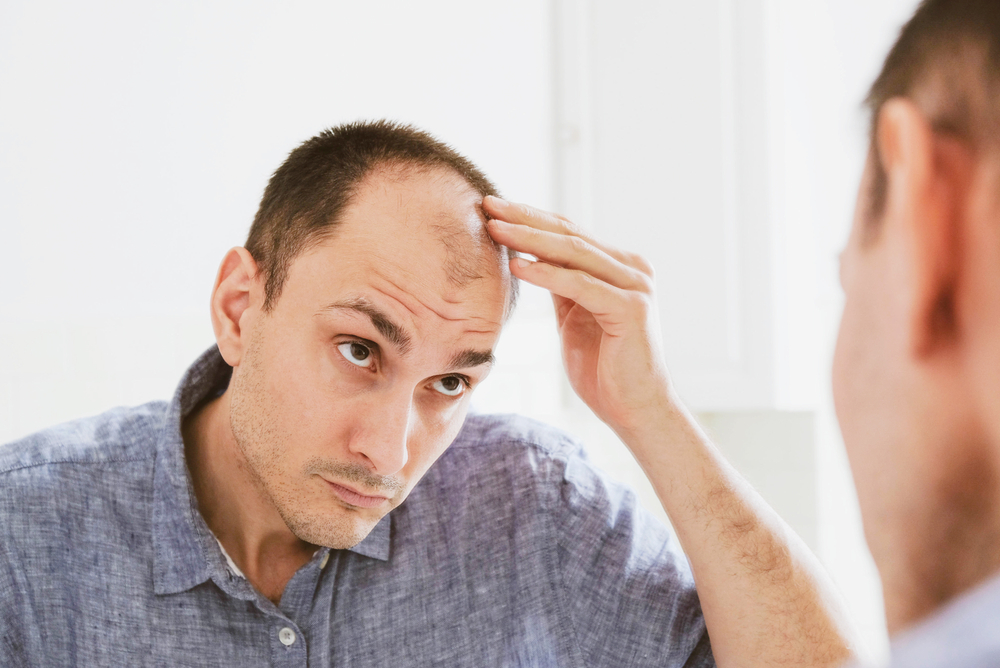- Male Pattern Baldness typically starts at the hairline. It usually recedes to form an “M” shape but it can also develop on the crown of the head.
- Hair loss isn’t usually a cause for concern but in some cases, it can be linked to medical conditions which is why you should talk to your doctor.
- For some men, hair loss is simply a natural part of growing older while others experience negative psychological effects, such as low self-esteem, anxiety, or depression. Luckily, there are some treatment options that may help.
As much as we try to escape it, aging is a natural part of life and so are some of the side effects that come with it. Hair loss is no exception. The National Library of Medicine points out that almost everyone has some hair loss with aging. Hair growth also slows down as we grow older too.
Unfortunately, men are more susceptible to hair loss compared to women. This is because men are constantly producing testosterone and making DHT which makes them more likely to lose their hair. Women don’t have a similar genetic disposition. If you’re starting to lose your hair, here’s what you need to know about male pattern baldness including the common signs, causes, and possible treatment options.
What Is Male Pattern Baldness?
Everyone loses hair every day. In fact, the American Academy of Dermatology Association (AAD) says it’s normal to shed between 50 to 100 strands per day. But when your hair falls out, it usually grows back and the cycle repeats. However, most men will notice that they start losing more hair as they age, and that hair stops growing back. This may be known as male pattern baldness (also called androgenetic alopecia) and it’s the most common type of hair loss in men.
If it’s happening to you, you should know you’re not alone. It affects about 50 million men in the United States. The National Library of Medicine also notes more than 50-percent of men over the age of 50 will experience male pattern baldness to some degree.
Common Signs of Male Pattern Baldness
Male pattern baldness usually starts at the hairline. Over time, the hairline recedes and forms an “M” shape, says Penn Medicine. For some men, the hairline will continue receding until all or most of their hair is gone.
Another sign of male pattern baldness is hair loss on the crown of the head. It’s common for this circular area to thin and expand in size over time. “Eventually the hair becomes finer, shorter, and thinner, and creates a U-shaped (or horseshoe) pattern of hair around the sides of the head and a bald area on the back of the head,” explains the source.
Are There Any Risks?
Hair loss isn’t usually a cause for concern, however, it can be linked to some medical conditions. In some cases, male pattern baldness can be associated with other medical problems such as coronary heart disease, hypertension, prostate cancer, and diabetes, says WebMD.
It’s important to keep track of how much hair you’re losing to identify any patterns that aren’t normal. To rule out any serious conditions, contact your doctor.
 novak.elcic / Shutterstock
novak.elcic / ShutterstockWhen to See a Doctor
If you notice sudden hair loss or that you’re losing more than usual when washing your hair, then it’s time to see a doctor. Other signs that warrant a doctor’s visit include hair loss that develops in an atypical pattern, widespread shedding, hair loss in patches, or excessive hair breakage.
Skin irritation, itchiness, scaling, or pain along with hair loss is also a cause for concern. Finally, if you start losing hair after starting a new medication then you should also book an appointment to see your doctor to find out if this is a normal side effect.
What Causes Male Pattern Baldness?
The most common cause of male pattern baldness is genetics or a family history of baldness. Healthline explains research says male pattern baldness is associated with a male hormone called androgens which is responsible for regulating hair growth, along with other functions.
Furthermore, your hair has a growth cycle. The source says, “with male pattern baldness, this growth cycle begins to weaken and the hair follicle shrinks, producing shorter and finer strands of hair.” Over time the growth cycle stops which leads to permanent hair loss.
Other Causes
Male pattern baldness that is caused by genetics doesn’t typically have any side effects besides hair loss. However, when it’s caused by a more serious health issue, you may develop other symptoms.
Other possible causes of male pattern baldness include thyroid conditions, cancer, or medication. To rule out these causes your doctor will perform a physical exam, review your medical history, and examine your pattern of hair loss. Your doctor may also require additional tests such as blood tests or a skin biopsy to rule out other disorders.
Who’s at Risk?
Now that we know a little bit more about male pattern baldness, you might be wondering who’s at risk? While male pattern baldness can start in your teenage years, it’s more common in adult men, says Healthline. The likelihood also increases with age.
Genetics typically plays a major role in its development, meaning men who have family members with male pattern baldness have a higher risk of developing it. Healthline says, “this is particularly true when their relatives are on the maternal side of the family.”
Male Pattern Baldness Treatment Options
Male pattern baldness isn’t always a sign of an underlying health problem, but that doesn’t mean it can’t affect you in other ways. For some men, hair loss is simply a natural part of growing older while others experience negative psychological effects, such as low self-esteem, anxiety, or depression.
The good news is some treatments exist that may help reduce hair loss, such as medication or a special shampoo. There are other options too. Let’s take a closer look at what they are next.
Hair Transplantation Is an Option
Another treatment option you can consider is hair transplantation. This involves taking hair from somewhere else and grafting it onto the scalp. “Hairs in the lower part of the back of the scalp are more resistant to androgens, and so they are used in surgical transplants,” explains Medical News Today.
The source says the surgery can be performed in two ways. First, they may take a strip of skin that has hair from another part of the head and graft it onto the bald area. The second option is transplanting individual hairs. This option may be more favorable because it avoids scarring.
It’s important to point out that hair transplants are expensive and they aren’t usually covered by health insurance.
Other Treatment Options
Medical News Today says laser and light therapies are other popular treatment options for male pattern baldness. The course of laser therapy may last up to 12-months. Keep in mind, the source also notes that these types of therapies have not been proven to prevent or slow male pattern baldness, and the “FDA has not approved them for efficacy.”
Some individuals turn to vitamins and supplements to help treat their hair loss but again, the FDA has not deemed these methods effective or safe, says the source.
Tips to Manage: Hairstyles
Some individuals choose to accept their hair loss and that is completely okay. But if you’re not quite ready to accept it but you also don’t want to commit to a hair transplant, know you still have options.
For starters, if you have limited hair loss, you might be able to hide it with the right haircut or hairstyle. Talk to your hairstylist to help find the right haircut for you.
Tips to Manage: Wig or Weave
Another option is investing in a wig, hairpiece, or weave. Wigs and hairpieces come in a variety of colors, styles, and textures. Some individuals prefer this option because they’re temporary, meaning you can take them off when you want to.
The other option is a weave which is a wig that is sewn into your natural hair. This also means you must have enough hair to sew the weave into. Unlike wigs, weaves stay on which means they don’t have to be removed to swim, shower or sleep. However, one disadvantage is that they must be resewn when new hair grows and this process may damage your natural hair, explains Healthline.
Tips to Manage: Counseling
Unfortunately, there’s no way to prevent male pattern baldness. So once it starts, you’ll need to either seek out treatment options or learn to accept it. That’s not to say it isn’t a big change and accepting your new appearance can be a challenge.
If you’re experiencing low self-esteem, anxiety, depression, or other emotional distress from your hair loss then it may be time to see a therapist. Talk therapy may help you accept your new changes and help you learn coping strategies to increase your self-esteem.















